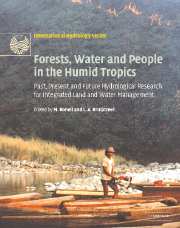 Forests, Water and People in the Humid Tropics
Forests, Water and People in the Humid Tropics Book contents
- Frontmatter
- Contents
- List of contributors
- Foreword
- Preface
- Acknowledgements
- Symposium and Workshop
- Introduction
- Part I Current trends and perspectives on people–land use–water issues
- Part II Hydrological processes in undisturbed forests
- Part III Forest disturbance, conversion and recovery
- Part IV New methods for evaluating effects of land-use change
- 27 Remote sensing tools in tropical forest hydrology: new sensors
- 28 Detecting change in river flow series
- 29 How to choose an appropriate catchment model
- 30 The disaggregation of monthly streamflow for ungauged sub-catchments of a gauged irrigated catchment in northern Thailand
- 31 Parsimonious spatial representation of tropical soils within dynamic rainfall—runoff models
- 32 Isotope tracers in catchment hydrology in the humid tropics
- 33 Process-based erosion modelling: promises and progress
- 34 Impacts of forest conversion on the ecology of streams in the humid tropics
- Part V Critical appraisals of best management practices
- Conclusion: Forests, water and people in the humid tropics: an emerging view
- Plate section
- References
27 - Remote sensing tools in tropical forest hydrology: new sensors
from Part IV - New methods for evaluating effects of land-use change
Published online by Cambridge University Press: 12 January 2010
- Frontmatter
- Contents
- List of contributors
- Foreword
- Preface
- Acknowledgements
- Symposium and Workshop
- Introduction
- Part I Current trends and perspectives on people–land use–water issues
- Part II Hydrological processes in undisturbed forests
- Part III Forest disturbance, conversion and recovery
- Part IV New methods for evaluating effects of land-use change
- 27 Remote sensing tools in tropical forest hydrology: new sensors
- 28 Detecting change in river flow series
- 29 How to choose an appropriate catchment model
- 30 The disaggregation of monthly streamflow for ungauged sub-catchments of a gauged irrigated catchment in northern Thailand
- 31 Parsimonious spatial representation of tropical soils within dynamic rainfall—runoff models
- 32 Isotope tracers in catchment hydrology in the humid tropics
- 33 Process-based erosion modelling: promises and progress
- 34 Impacts of forest conversion on the ecology of streams in the humid tropics
- Part V Critical appraisals of best management practices
- Conclusion: Forests, water and people in the humid tropics: an emerging view
- Plate section
- References
Summary
INTRODUCTION
Increasingly, the monitoring of forest condition and productivity requires better spatial context, more detail and higher temporal resolution, if we are to be able to visualise key environmental or biodiversity indicators and their changes across space and time. For the accurate prediction of how changes in climate, forest condition or land-use can impact large-scale hydrological processes, researchers and water managers are also faced with the need to extrapolate patch-scale measurements to whole catchments or river basin scales. This is especially challenging across large, often inaccessible areas or where the ground information available is sparse and where the costs and effort required in setting up a dedicated, sufficiently dense network of ground-based sampling sites are very high.
Although not always measuring the required hydrological variables directly, remote sensing techniques can provide valuable information about the spatial variability of key surface characteristics across large scales. For this reason it is often used as a cost-effective mechanism for extrapolation of point-based measurements, or as a constraint for hydrological model outputs. The key to the effective use of this type of data, in conjunction with hydrological models, lies in the recognition of the characteristics and trade-offs found in the different forms of remotely sensed derived variables, and how they can be used to complement ground-based hydrological measurements effectively.
Up to now, mostly broad-band, low resolution remotely sensed data have been used as input and constraints for regional/ continental hydrology and productivity models (e.g. Running and Coughlan, 1988; Schultz and Engman, 2000).
- Type
- Chapter
- Information
- Forests, Water and People in the Humid TropicsPast, Present and Future Hydrological Research for Integrated Land and Water Management, pp. 675 - 702Publisher: Cambridge University PressPrint publication year: 2005
References
- 1
- Cited by


